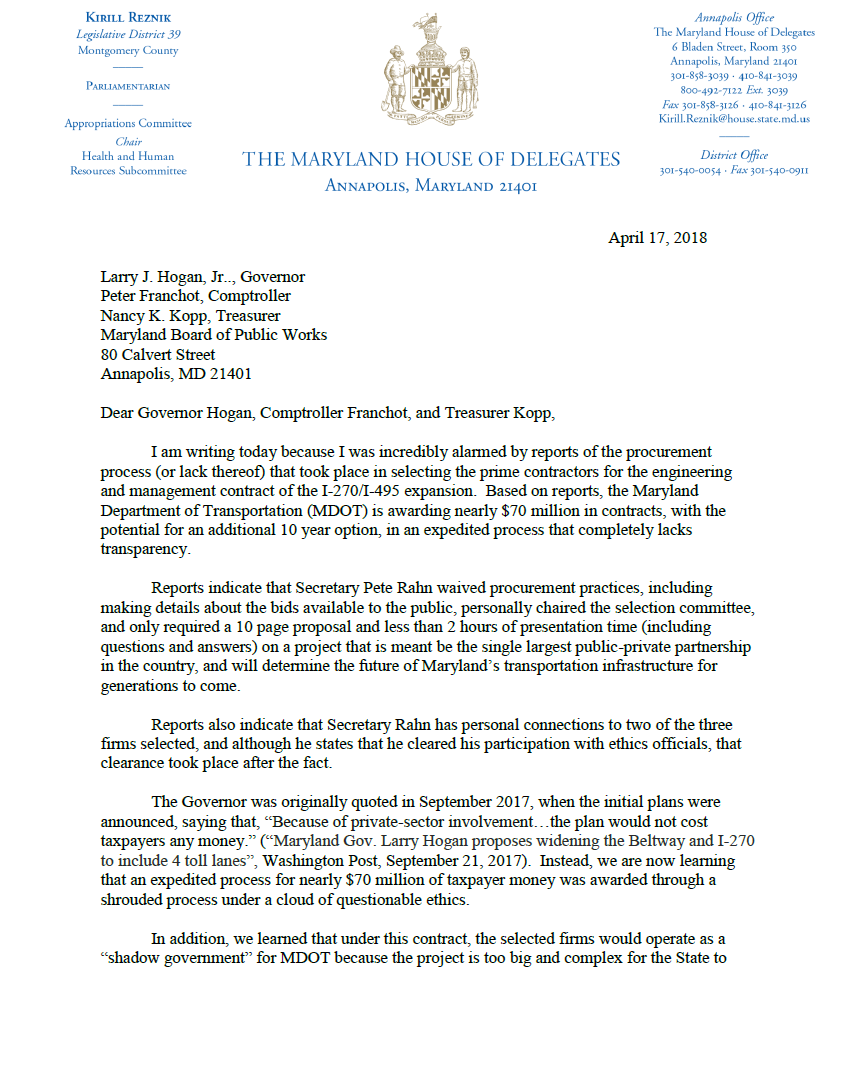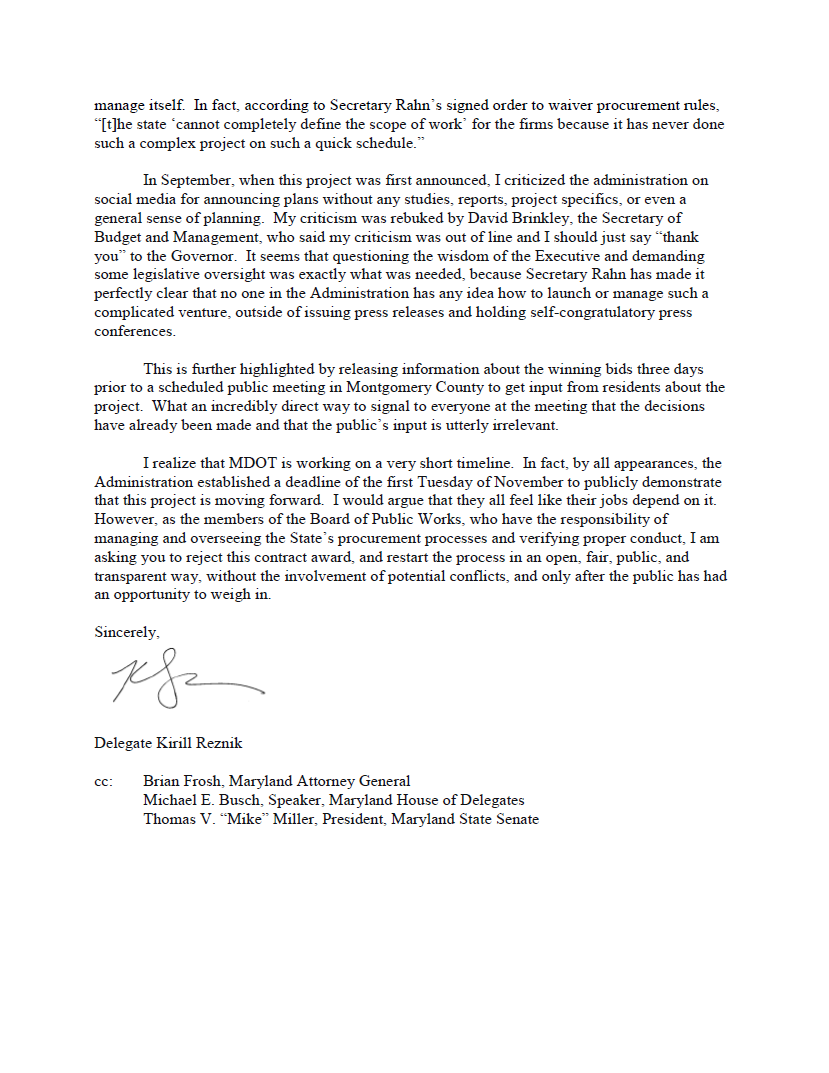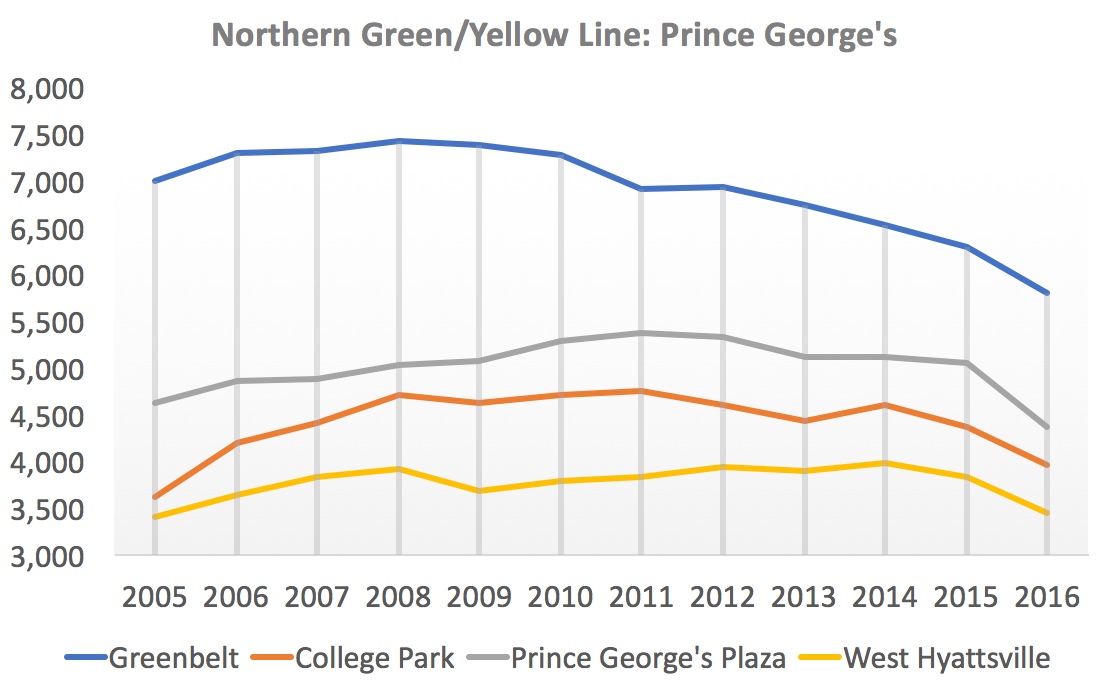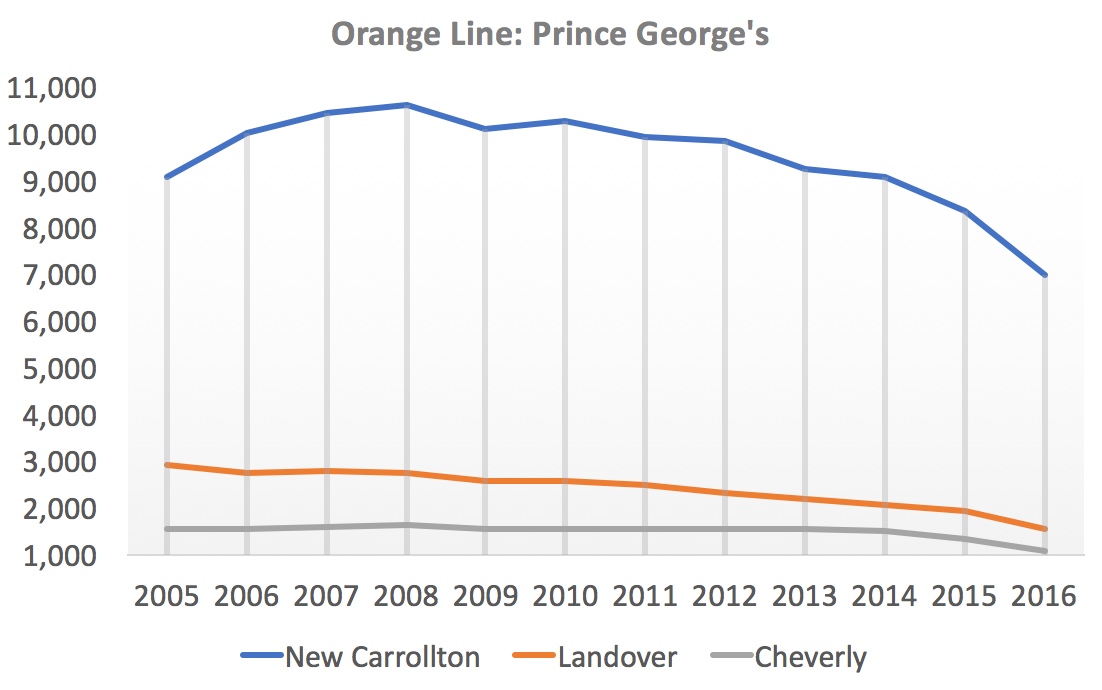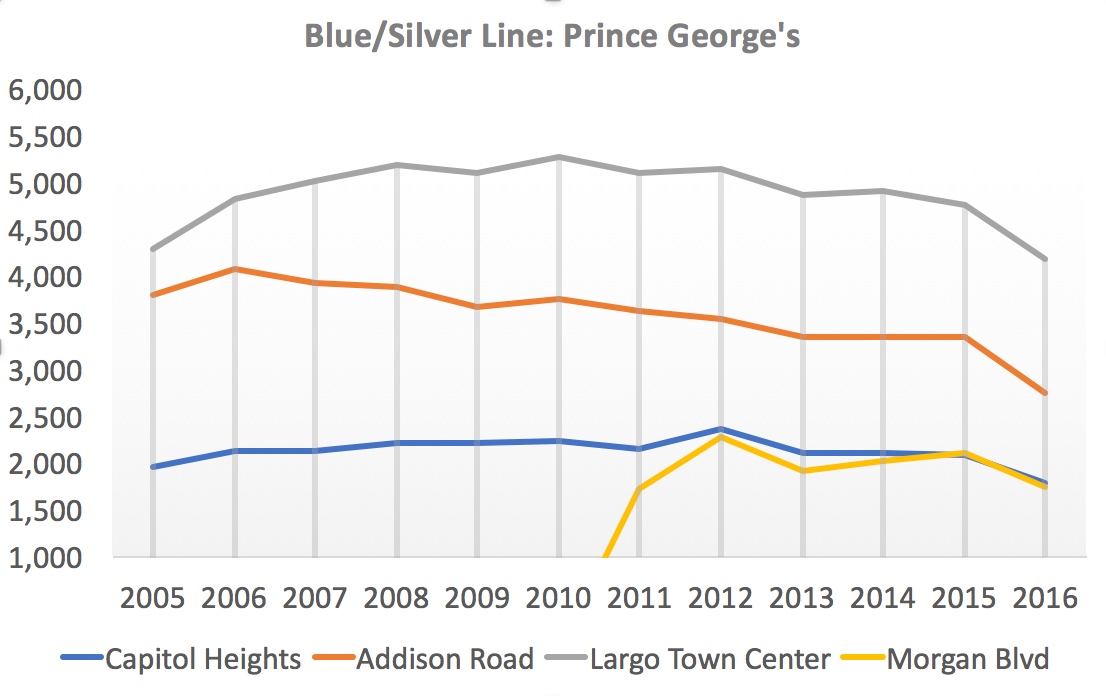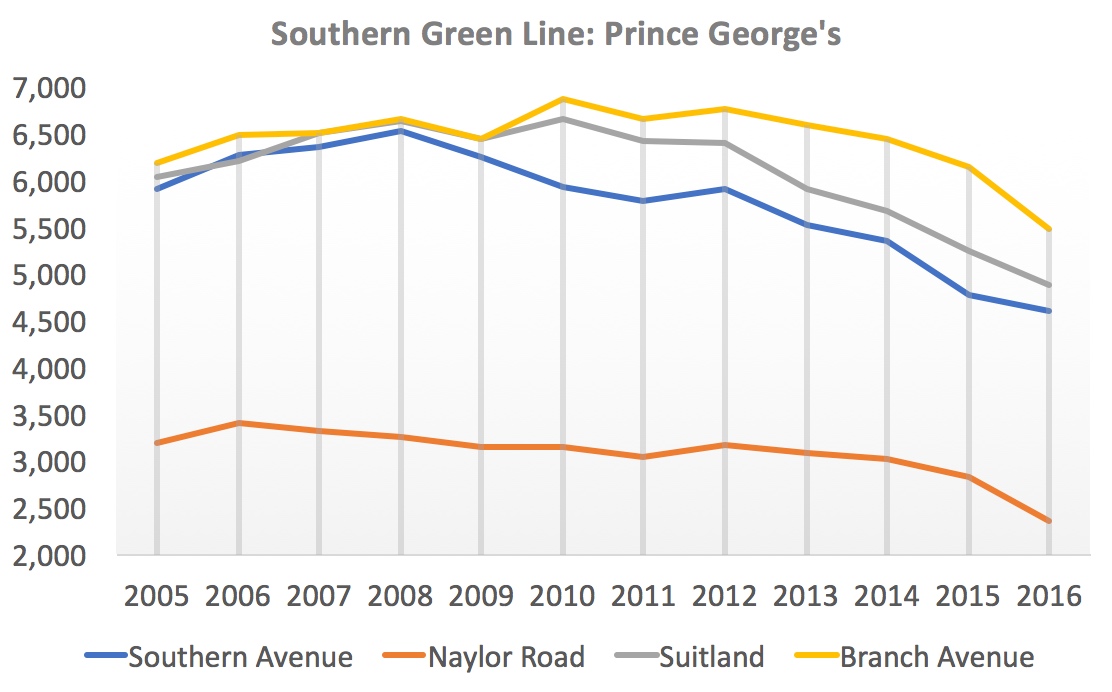The following post by Councilmember Marc Elrich (D-At Large) continues Seventh State’s series on reactions to Gov. Larry Hogan’s road proposal by candidates for county executive. It appeared previously on Maryland Matters.
Recently, Gov. Larry Hogan (R) announced his $9 billion proposal to add toll lanes to I-270, I-495 and the Baltimore-Washington Parkway. While a number of people have initially enthusiastically supported his proposal, I think it bears a lot more scrutiny.
The best thing about it is that the governor shows a willingness to invest in infrastructure, though how much is state money and how much is user tolls is not known.
One of the problems is that he’s proposing a sledge hammer for a project that needs a scalpel. The scope of the proposed solutions for I-270 and I-495 are overly grandiose and unnecessary. On I-270 a more sensible approach would be two reversible lanes from the county line to the Beltway, which is what the County Council proposed several years ago. There isn’t room for four lanes, and it’s an unnecessary expense, because the congestion on I-270 is directional – meaning from north to south in the morning and the reverse in the evening. (It is also known as peak direction.)
Neither side of the road needs these lanes outside of the peak direction at rush hour. Reversible lanes are the most efficient use of money and space. These lanes should be for express bus and high-occupancy vehicles only.
On I-495 there are serious space constraints, particularly between New Hampshire Avenue and 355. Not only are there many houses close and a major hospital almost immediately adjacent to the highway, but there are also legal constraints regarding encroachments on Rock Creek. Multiple lanes would be an environmental disaster for Rock Creek.
Additionally, large sections of the Montgomery County portion would be astoundingly expensive – remember the overpass bridges don’t have enough room for four lanes of new highway. Instead, a single reversible lane might fit within the existing width of the highway. Engineering data would be needed to confirm this, but there seem to be at least some places wide enough to add a lane now using the inside shoulder service lane. It may be possible to add two lanes past 355 going to Virginia – reversible lanes should be used there as well. Why build what you don’t need?
Gov. Hogan is missing two bigger picture problems: transit in general and Metro in particular. If money is available for highway expansion, then money is available for Metro. Metro cannot fail – in fact, it needs to improve and absorb more riders from the roads. A Metro fail would devolve into a widespread road disaster because most people would use local roads, not the highways, to get around.
Because no highway goes into Washington, D.C., a Metro failure adds thousands of cars on Georgia, Connecticut and Wisconsin avenues. Those additional cars would flood the commute to the city as well as make a mess for those commuters trying to access the job centers along 355.
The second overarching problem is that the governor is not looking at the big picture. The Beltway and I-270 have congestion problems, but what happens when exiting these roads is equally problematic. Even if, for example, cars on the Beltway arrive quickly to Georgia Avenue at rush hour, they would face a long queue simply to exit the Beltway and then a slow slog on Georgia. In other words, the local road network is already overwhelmed and no amount of highway lanes can change that situation. So even if cars spend less time on 495 getting to an exit and then they are stuck on the exit ramp or on the road, where are the savings?
The realities of the commutes necessitate a commitment to local transit. Local transit is the only way to clear enough space off the roads so that people can get to their destinations in a reasonable amount of time.
Because building new local road lanes won’t work, increasing transit usage on the local road network is central to any solution.
The whole point of the Bus Rapid Transit (BRT) network that I proposed was to increase mobility on local roads and take a load off the already overwhelmed road network. (I first proposed the BRT network in 2008 and it is slowly developing.) BRT built right and desirable to use will provide actual congestion relief – just imagine what the roads would function like without a Metro and if those passengers returned to their cars.
Any plan that doesn’t integrate the local roads and the highways is simply not going to work. The governor should look more carefully at what is needed, rather than just declaring the addition of four lanes to the highway at great public expense, whether four lanes are needed or not. A more strategic assessment would free up capital that could go toward a more comprehensive, successful solution.
And, there are two other things to consider. A public private partnership, or P3, may be the most expensive way to fund a project and that is going to reverberate in tolls. Essentially, people with money to spend get a better highway experience and those without the means, remain in a poor experience. If money is the ticket to the new lanes, then you’re disincentivizing car pools, van pools and buses.
We need to get cars off the road, rather than finding extravagant ways to keep them on the road. This is a huge public expenditure with no accompanying analysis of what the state won’t be able to fund as a result – I’m worried about education, transit funding, and other critical infrastructure. Since none of us believes that there’s an infinite well of money, an expenditure like this on three roads may well mean that other critical projects don’t get done.
Another unknown is the impact of increased telecommuting. If we could get 15-20 percent of the workforce telecommuting each work day, we’d be dealing with a far less expensive problem to solve and probably have a much better travel environment.
I know the governor’s announcement makes a great news splash, and it certainly allows Gov. Hogan to say “I’m committed,” but it’s not very well thought out beyond that. I’d like to take the actual state dollars he’s offering and then have a real conversation about a comprehensive solution to the problem that actually makes better connections where trips start and where they end. And transit must be the central part of that conversation.



